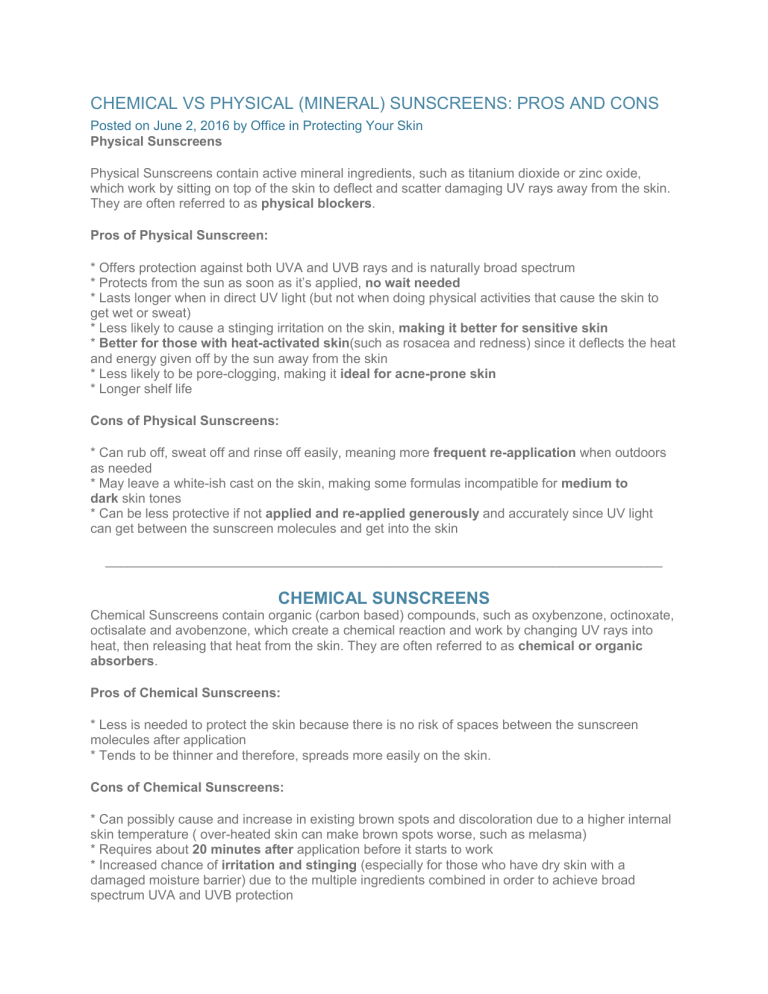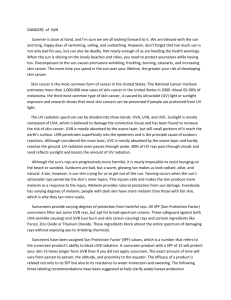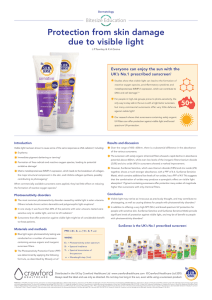
CHEMICAL VS PHYSICAL (MINERAL) SUNSCREENS: PROS AND CONS Posted on June 2, 2016 by Office in Protecting Your Skin Physical Sunscreens Physical Sunscreens contain active mineral ingredients, such as titanium dioxide or zinc oxide, which work by sitting on top of the skin to deflect and scatter damaging UV rays away from the skin. They are often referred to as physical blockers. Pros of Physical Sunscreen: * Offers protection against both UVA and UVB rays and is naturally broad spectrum * Protects from the sun as soon as it’s applied, no wait needed * Lasts longer when in direct UV light (but not when doing physical activities that cause the skin to get wet or sweat) * Less likely to cause a stinging irritation on the skin, making it better for sensitive skin * Better for those with heat-activated skin(such as rosacea and redness) since it deflects the heat and energy given off by the sun away from the skin * Less likely to be pore-clogging, making it ideal for acne-prone skin * Longer shelf life Cons of Physical Sunscreens: * Can rub off, sweat off and rinse off easily, meaning more frequent re-application when outdoors as needed * May leave a white-ish cast on the skin, making some formulas incompatible for medium to dark skin tones * Can be less protective if not applied and re-applied generously and accurately since UV light can get between the sunscreen molecules and get into the skin ____________________________________________________________________________ CHEMICAL SUNSCREENS Chemical Sunscreens contain organic (carbon based) compounds, such as oxybenzone, octinoxate, octisalate and avobenzone, which create a chemical reaction and work by changing UV rays into heat, then releasing that heat from the skin. They are often referred to as chemical or organic absorbers. Pros of Chemical Sunscreens: * Less is needed to protect the skin because there is no risk of spaces between the sunscreen molecules after application * Tends to be thinner and therefore, spreads more easily on the skin. Cons of Chemical Sunscreens: * Can possibly cause and increase in existing brown spots and discoloration due to a higher internal skin temperature ( over-heated skin can make brown spots worse, such as melasma) * Requires about 20 minutes after application before it starts to work * Increased chance of irritation and stinging (especially for those who have dry skin with a damaged moisture barrier) due to the multiple ingredients combined in order to achieve broad spectrum UVA and UVB protection * The higher the SPF (such as formulas of SPF 50 or greater), the higher the risk of irritation for sensitive skin types * The protection it offers gets used up more quickly when in direct UV light, so re-application must be more frequent. * Increased chance of redness for rosacea-prone skin types because it changes UV rays into heat which can exacerbate flushing * May clog pores for oily skin types Which SPF NUMBER Is the Best To Use Higher numbers on labels are more about marketing. In fact the FDA is proposing to ban sunscreens that are labeled with an SPF number higher than 50. There is no scientific evidence showing that they offer any more protection than lower numbers. Suggested recommendation is a minimum of an SPF of 30 and a maximum of 50. ANTI – AGING With any sunscreen, it’s important to use an antioxidant serum underneath. It helps prevent oxidative stress that leads to visible aging and can increase the effectiveness of sunscreen by four times due to the combination of vitamin C and E. Comments are closed.

